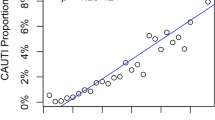Abstract
Objective
To describe the occurrence, microbiology, and risk factors of catheter-associated urinary tract infections (CA-UTI) in critically ill children.
Methods
We conducted a review of hospital records for CA-UTI in the pediatric intensive care unit (PICU) over a 7-year period (2014–2020).
Results
62 CA-UTI cases (48% boys, median (IQR) age 36 (12,96 month) were identified during the study period with occurrence rate of 7.2/1000 catheter-days. The most common organisms were Escherichia coli (32.4%) and Enterococcus faecalis (30.6%). Using a multivariate logistic regression analysis, the significant associated variables for CA-UTI were duration of catheter drainage (a OR (95% CI) 1.14, (1.03,1.27), P=−0.009), PICU stay (aOR (95% CI) 1.13 (1.05,1.21) (P<0.001), and hospital stay (aOR (95% CI): 1.03 (1.01,1.06), P=0.015).
Conclusion
CA-UTI is not an uncommon nosocomial infection in PICU. The risk increases with increasing duration of catheter drainage, and hospital or PICU stay.
Similar content being viewed by others
References
Magill SS, O’Leary E, Janelle SJ, et al. Changes in prevalence of health care—associated infections in U.S. hospitals. New Eng J Med. 2018;379:173244.
Plowman R, Graves N, Esquivel J, Roberts JA. An eco-nomic model to assess the cost and benefits of the routine use of silver alloy coated urinary catheters to reduce the risk of urinary tract infections in catheterized patients. J Hosp Infect. 2001;48:33–42.
Lo E, Nicolle LE, Coffin SE, et al. Strategies to prevent catheter associated urinary tract infections in acute care hospitals:2014 update. Infection Control and Hospital Epidemiology. 2014;35:464–79.
Platt R, Polk BF, Murdock B, Rosner B. Mortality associated with nosocomial urinary-tract infection. N Engl J Med. 1982;307:637–42.
Centers for Disease Control and Prevention. National Healthcare Safety Network (NHSN), Device associated module-UTI:2022. Accessed Jan 03, 2022. Available from: https://www.cdc.gov/nhsn/pdfs/ps-analysis-resources/linelists.pdf
Temiz E, Piskin N, Aydemir H, et al. Factors associated with catheter associated urinary tract infections and the effects of other concomitant nosocomial infections in intensive care units. Scand J Infect Dis. 2012;44:344–9.
Pollack MM, Patel KM, Ruttimann UE. PRISM III: an updated Pediatric Risk of Mortality score. Critical care medicine. 1996;24:743–52.
Alten JA, Rahman AF, Zaccagni HJ, et al. The epidemio-logy of health-care associated infections in pediatric cardiac intensive care units. The Pediatric Inf Dis J. 2018;37:768.
Brilli RJ, McClead Jr RE, Crandall WV, et al. A comprehensive patient safety program can significantly reduce preventable harm, associated costs, and hospital mortality. The J Pediatr. 2013;163:1638–45.
Ramayani OR, Siregar RS, Eyanoer PC, et al. Catheter-associated urinary tract infection in children: A discri-minant analysis prediction model to prevent it. Curr Ped Res. 2017;21:420–24.
Rinke ML, Oyeku SO, Heo M, et al. Pediatric ambulatory catheter-associated urinary tract infections (CAUTIs): Incidence, risk factors, and patient outcomes. Infect Cntrl Hosp Epidemiol. 2020;41:1–9.
Goudie A, Dynan L, Brady PW, et al. Costs of venous thromboembolism, catheter-associated urinary tract infection, and pressure ulcer. Pediatrics. 2015;136:432–9.
Fernando MM, Luke WA, Miththinda JK, et al. Extended spectrum beta-lactamase producing organism causing urinary tract infection in Sri Lanka and the antibiotic susceptibility pattern-A hospital based cross sectional study. BMC Infect Dis. 2017:17.
Samraj R, Stalets E, Butcher J, et al. The impact of Catheter-Associated Urinary Tract Infection (CA-UTI) in critically ill children in the pediatric intensive care unit. J Pediatr Intensive Care. 2015;5:7–11.
Letica Kriegel AS, Salmasian H, Vawdrey DK, et al. Identifying the risk factors for catheter associated urinary tract infections: a large cross sectional study of six hospitals. BMJ Open. 2019;9:e022137.
Funding
Funding: None; Competing interests: None stated.
Author information
Authors and Affiliations
Contributions
Contributors: LAV: contributed to data collection, analysis of the data and writing of the manuscript. MP: contributed to study design, analysis of data and writing of the manuscript; SV: contributed to critical review of the manuscript; and SG: contributed to statistical analysis and review of the manuscript. All authors approved the final version of manuscript and are accountable for all aspects related to the study.
Corresponding author
Ethics declarations
Ethics clearance: IEC, St John’s Medical College; No. 94/2019 dated March 14, 2019.
Additional information
Note: Additional material related to the study is available with the online version at https://www.indianpediatrics.net
Electronic supplementary material
Rights and permissions
About this article
Cite this article
Lalitha, A.V., Paul, M., Nagraj, S. et al. Risk Factors for Catheter-Associated Urinary Tract Infections (CA-UTI) in the Pediatric Intensive Care Unit. Indian Pediatr 59, 613–616 (2022). https://doi.org/10.1007/s13312-022-2573-7
Received:
Revised:
Accepted:
Published:
Issue Date:
DOI: https://doi.org/10.1007/s13312-022-2573-7




